This Model - the GA Supermodel - is Geoscience Australia's overarching data model that provides integration logic for data elements in many of GA’s specialised domains. It also provides logic for Persistent Identifier (PID) patterning. It is based on the general-purpose Supermodel Model.

1. Metadata
IRI |
|
Title |
Geoscience Australia Supermodel Specification |
Description |
This Model - the GA Supermodel - is Geoscience Australia's overarching data model that provides integration logic for data elements in many of GA’s specialised domains. It also provides logic for Persistent Identifier (PID) patterning. |
Created |
2021-12-14 |
Modified |
2022-05-23 |
Issued |
0000-00-00 |
Creator |
|
Publisher |
|
License |
|
Machine-readable form |
2. Preamble
2.1. Abstract
This Model - the GA Supermodel - is Geoscience Australia's overarching data model that provides integration logic for data elements in many of GA’s specialised domains. It also provides logic for Persistent Identifier (PID) patterning. It is based on the general-purpose Supermodel Model.
2.2. Namespaces
This model is built on a "baseline" of Semantic Web models which use a variatey of namespaces. Prefixes for thess namespaces, used througout this document, are listed below.
| Prefix | Namespace | Description |
|---|---|---|
|
the Supermodel meta-model |
|
|
Dublin Core Terms vocabulary namespace |
|
|
Generic examples namespace |
|
|
Web Ontology Language ontology namespace |
|
|
RDF Schema ontology namespace |
|
|
Sensor, Observation, Sample, and Actuator ontology namespace |
|
|
Simple Knowledge Organization System (SKOS) ontology namespace |
|
|
Time Ontology in OWL namespace |
|
|
Vocabulary of Interlinked Data (VoID) ontology namespace |
|
|
XML Schema Definitions ontology namespace |
2.3. Terms & Definitions
The following terms appear in this document and, when they do, the definitions in this section apply to them.
The following terms appear in this document and, when they do, the definitions in this section apply to them. This section’s content is also presented online in a formal vocabulary at:
| Term | IRI | Definition | Source |
|---|---|---|---|
Central Classes are the generic data classes at the centre of Data Domains with high-level relationships between them defined in this supermodel. These classes are taken from general standards - usually well-known international stadnards - and the Indigenous Data Network specialises and extends them to make specific, custom, classes for their needs. |
Supermodel model |
||
A data model for a particular component of a Supermodel. The Component Data Model may have been designed for a particular Supermodel that uses t but it may also pre-exist and it just indicated for use within the Supermodel. A Supermodel will always need to provide mappings from classes within a Component Data Model to other Supermodel elements for interoperability |
Supermodel model |
||
High-level conceptual areas within which Geosicence Australia has data. These Data Domains are not themed scientificly - 'geology', 'hydrogeology', etc. - but instead based on parts of the Observations & Measurement [ISO19156] standard, realised in Semantic Web form in the SOSA Ontology, part of the Semantic Sensor Network Ontology [SSN]. Current Data Domain are shown in Figure 1. |
Supermodel model |
||
A Knowledge Graph is a dataset that uses a graph data tructure - nodes and edges - with strongly-defined elements. |
Common use, e.g. https://en.wikipedia.org/wiki/Knowledge_graph |
||
A set of technologies and conventions defined by the World Wide Web Consortium that aim to present data in both human- and machine-readable form over the Internet. Linked Data is strongly-defined with each element having either a local definition or a link to an available definition on the Internet. Linked Data is graph-based in nature, that is it consistes of nodes and edges that can forever be linked to further conceps with defined relationships. |
|||
The World Wide Web Consortium's vision of an Internet-based web of Linked Data. Semantic Web is used to refer to something more than just the technologies and conventions of Linked Data; the term also encompases a specific set of interoperable data models - often called ontologies - published by the W3C, other standards bodies and some well-known companies. The 'semantic' refers to the strongly-defined nature of the elements in the Semantic Web: the meaning of Semantic Web data is as precicely defined as any data can be. |
2.4. Conventions
All model diagrams use elements introduced in Figure 1. These elements are defined in the RDF, RDFS and OWL ontologies, see [OWL] for mode details.
All code snippets in this document, used to show formal and machine-readable versions of concepts, are expressed using the Turtle RDF syntax [TTL].
3. Introduction
This model described a set of Data Domains with Central Classes that are associated using Linked Data principles. Specialisations of the Central Classes are made to cater for particular data needs.
Altogether, these things form a Knowledge Graph of data for Geoscience Australia that participates in the wider, international, Semantic Web.
This model is predicated on an assumption that GA is a data aggregation organisation and therefore data cataloguing is its major concern. At the centre of this model then is a domain of Data Cataloguing, the main elements of which are taken from the Data Catalog Vocabulary ([DCAT]). The things that GA’s data are mostly about are spatial things, hence a Data Domain of Spatiality, for which the GeoSPARQL [GEO] is core. The way GA generates information about spatial things is via observations and various forms of sampling, hence a Data Domain of Sampling and for this one the Sensor, Observation, Sample, and Actuator (SOSA) ontology [SSN] is mainly used as it which focuseses on observations and how they produce results, what the results are about and so on. GA’s data is cetegorised in various ways and for this the Data Domain of Theming is indicated. Within it, taxonomy representation using [SKOS] is paramount. Finally, all organisations relate their data and processes to thus who are responsible for them, thus the final Data Domain is indeed Organisations and People which is modelled using a number of models such as [DCTERMS], [PROV] and [SDO].
These models are also all Semantic Web models and they have been selected for their easy interoperability.
All elements of this model are modelled using the Web Ontology Language [OWL] and specailisations of it, such as the Simple Knowledge Observation System [SKOS] which is used for modelling taxonomies of concepts. As well as the textual and image descriptions of the model here, in the next Section, a machine-readable version of this model is available (see Metadata).
3.1. Uses
This model should be used to understand the broad relationships between any data elements within GA. It can also be used to inform policy that is based on GA’s overall data structure, for example persistent identifier (PID) policy for which there is a dedicated Annex, Annex A: PID Policy.
4. Model
This model, the actual GA Supermodel itself, is a profiling - specialised reusing - of multiple, well-known Semantic Web models. It is organised into a series of Levels which serve different purposed. All elements of the model are only defined once and the various Levels simply present views of the model at differnt levels of abstraction to serve their viarous intended purposes.
4.1. Level 0: Model Background
This view of the model is a backgrounding one which describes the underpinning model mecahnics that it uses. The object modelling used is based on the Web Ontology Language [OWL] and its own underlying use of RDF & RDFS [1]. The Provenance Ontology [PROV] is used to model real-world causal dependencies - provenance.
4.1.1. Diagram Key
The figure below is a key for the elements in all of the model diagrams in this document.

4.1.2. Object Modelling
The elements from the above subsection are shown in relation to one another in the figure below.
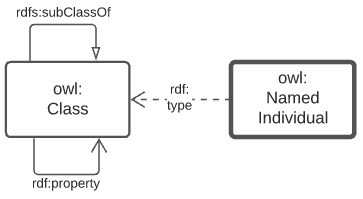
The elements shown above are identified with prefixed IRIs that correspond to entries in the Namespace Table. A short explanation of the diagram key elements is:
-
owl:Class- represents any conceptual class of objects. Classes are expected to contain individuals - instances of the class - and the class, as a whole, may have realtions to other classes -
owl:NamedIndividual- an individual of anowl:class. For example, for the class ships, an individual might be Titanic -
rdf:property- a relationship between classes, individuals, or any objects and Literals -
rdfs:subClassOf- anrdf:propertyindicating that the domain (from object) is a subclass of the range (to objects). An example is the class student which is a subclass of person: all students are clearly persons but not vice versa -
rdf:type- the property that related anowl:NamedIndividualto theowl:Classthat it’s a member of -
Literal- a simple literal data property, e.g. the string "Nicholas", or the number 42. Specific literal types are usually indicated when used
4.1.3. Provenance
General provenance/lineage information about anything - a rock sample, a dataset, a term in a vocabulary etc. - is described using the Provenance Ontology [PROV] which views everything in the world as being of one or more types in Figure 4.
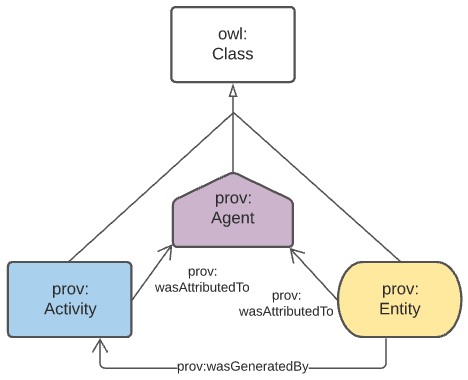
According to PROV, all things are either a:
-
prov:Entity- a physical, digital, conceptual, or other kind of thing with some fixed aspects -
prov:Agent- something that bears some form of responsibility for an activity taking place, for the existence of an entity, or for another agent’s activity -
prov:Activity- something that occurs over a period of time and acts upon or with entities
While not often in front of mind for objects in any Data Domain, provenance relations always apply, for example: a sosa:Sample within the Sampling domain is a prov:Entity and will necissarily have been created via a sosa:Sampling which is a prov:Activity. Another example: an sdo:Person related to a dcat:Dataset via the property dcterms:creator in the DataCataloging domain is a specialised form of a prov:Agent related to a prov:Entity via prov:wasAttributedTo.
4.2. Level 1: Data Domains
The top-level view of the GA supermodel that assumes Level 0 background mechanics shows a set of 5 Data Domains which are:
These are shown in Figure 2 below.
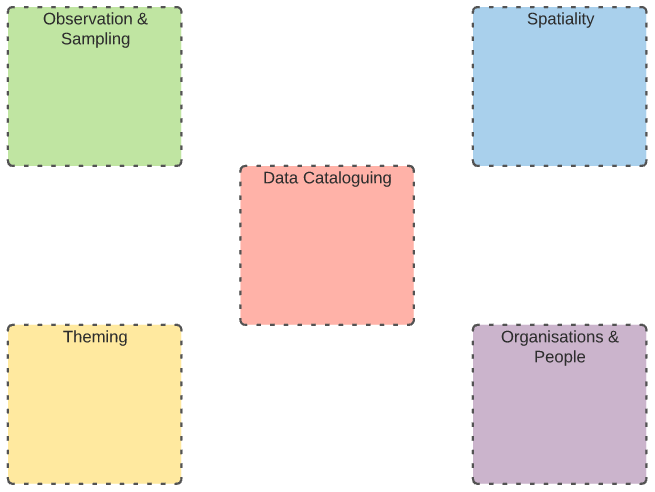
These Data Domains are defined formally in a simple SKOS vocabulary within this model’s set of machine-readable resources. The vocabulary may be access ddirectly at https://linked.data.gov.au/def/supermodel/data-domains.
Elements at all other levels of detail in this model are classified according to these Data Domains by use of the dcat:theme property, for example, the class sosa:Sample is within the Sampling Data Domain, so it is defined as follows:
sosa:Sample
a owl:Class ;
dcat:theme super:sampling ;
...
.|
Note
|
This supermodel’s origins are in GA’s geology and spatial data work and thus other areas of GA’s responsibility may not be adequately provided for with the Data Domains. While these current Data Domains are at a concpetual level above particular science domains and shouldn’t be extende to cater for science areas such as Offshore Petrolium Resources or responsibility areas such as Community Safety, it may still be necissary for these domains may be added to accomodate other GA work in some way. Extensions should occur as little as possible. |
4.3. Level 2: Central Classes
The next level of detail after the Data Domains introduces the Central Classes. Here the most significant, general, class per Data Domain is indicated, along with the main relationships between each of them. Figure 3 shows this.
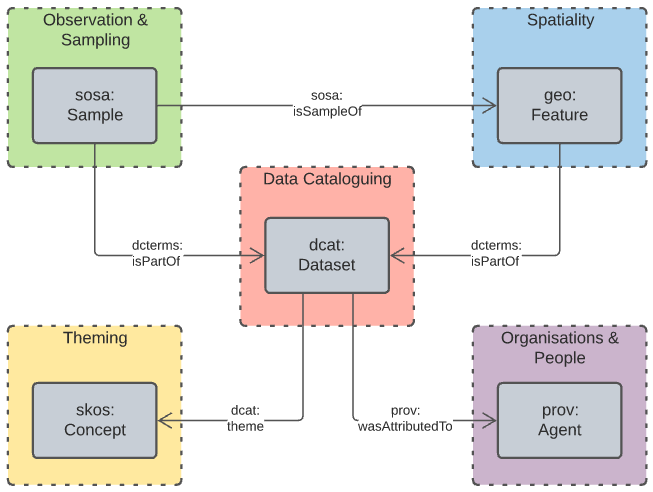
The Central Classes of each of the Data Domains are well-used classes from well-known models. For example, the Central Class of Organisation & People is [PROV]'s Agent class which is one of the three main classes of thing in PROV and used every time PROV is used to represent causal agents. PROV is used extensively to indicate how things - data, resources, systems - come to be.
A list of the Data Domains' Central Classes, their definitions, as given by their defining systems, and their defining system are given in Table 2 below.
| Data Domain | Central Class | Definition | Defined By |
|---|---|---|---|
Data Cataloguing |
|
A collection of data that is listed in the catalog. |
Data Catalog Vocabulary [DCAT] |
Sampling |
|
A Sample is the result from an act of Sampling. Feature which is intended to be representative of a FeatureOfInterest on which Observations may be made. Physical samples are sometimes known as 'specimens'. |
Sensor, Observation, Sample, and Actuator Ontology, within [SSN] |
Spatiality |
|
A discrete spatial phenomenon in a universe of discourse |
GeoSPARQL Ontology [GEO] |
Theming |
|
An idea or notion; a unit of thought |
Simple Knowledge Organization System ontology [SKOS] |
Organisations & People |
|
An agent is something that bears some form of responsibility for an activity taking place, for the existence of an entity, or for another agent’s activity |
PROV-O: The PROV Ontology [PROV] |
The definitions of the main relations between Central Classes are given in
| Central Class | Definition | Defined By |
|---|---|---|
|
A collection of data that is listed in the catalog. |
Data Catalog Vocabulary [DCAT] |
|
A Sample is the result from an act of Sampling. Feature which is intended to be representative of a FeatureOfInterest on which Observations may be made. Physical samples are sometimes known as 'specimens'. |
Sensor, Observation, Sample, and Actuator Ontology, within [SSN] |
|
A discrete spatial phenomenon in a universe of discourse |
GeoSPARQL Ontology [GEO] |
|
An idea or notion; a unit of thought |
Simple Knowledge Organization System ontology [SKOS] |
|
An agent is something that bears some form of responsibility for an activity taking place, for the existence of an entity, or for another agent’s activity |
PROV-O: The PROV Ontology [PROV] |
4.4. Level 3: Domain Main Classes
At this level, the main classes within each Data Domain are identified and related to one another. In each Data Domain there is a well-known model used for the majority of the classes and relations. These well-known models are indicated to ensure that they can be followed if extensions to this level’s modelling need to be made.
4.4.1. Data Cataloguing
This subsection details the main elements of the Data Cataloguing Data Domain.
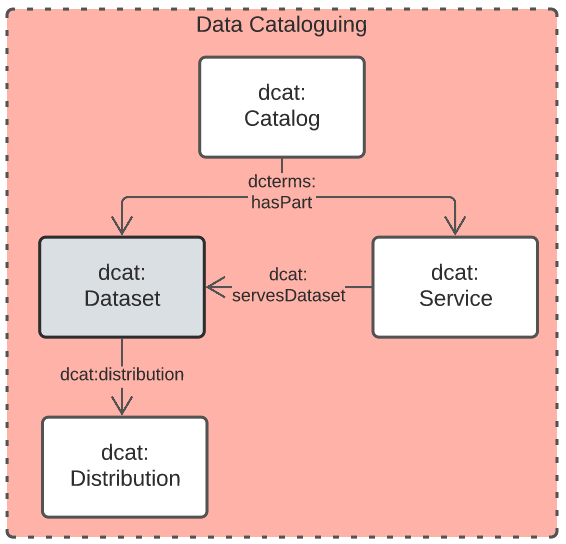
This Data Domain’s main classes are essentially the DCAT2 data model [DCAT] with a slight profiling: dcterms:hasPart should be used to indicate elements within catalogues (e.g. dcat:Dataset and other things within a dcat:Catalog) rather than the specialised properties of dcat:dataset because GA expects to catalogue many types of things and the type of the thing should be given by the thing, not the catalogue property used to indicate it.
4.4.2. Organisations & People
This subsection details the main elements of the Organisations & People Data Domain.
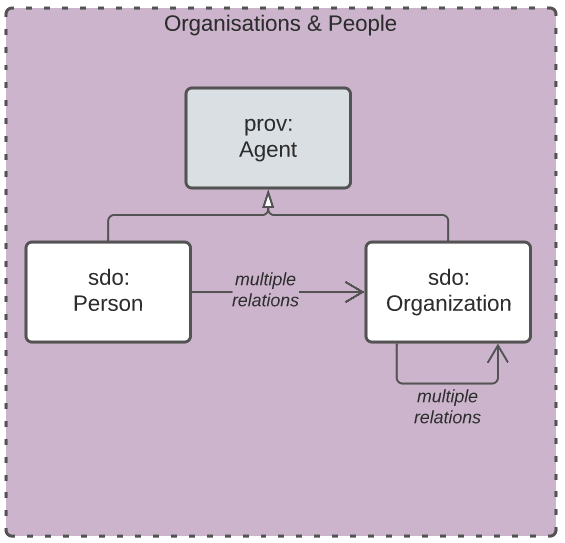
4.4.3. Sampling
This subsection details the main elements of the Sampling Data Domain.
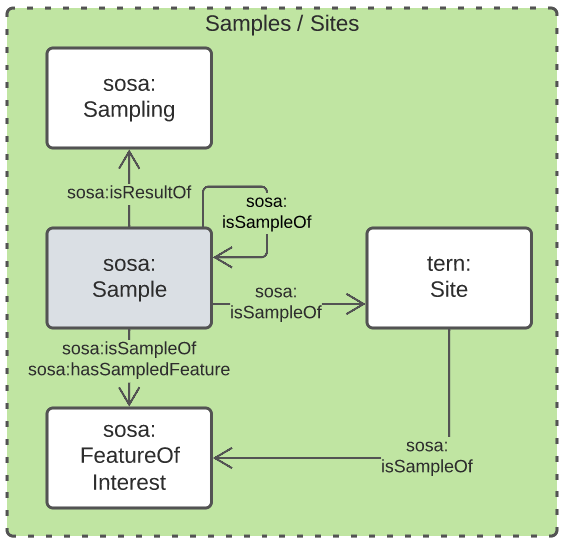
Most of this Data Domain’s main classes are taken directly from the Sensor, Observation, Sample, and Actuator Ontology (SOSA) which is part of the Semantic Sensor Networks Ontology [SSN] with only the tern:Site class taken from another model, the TERN Ontology [TERN], which is just a specialisation of SOSA anyway. The TERN Ontology is the domain model of the Australian Biodiversity Information Standard (ABIS) [ABIS] with which GA sampling data is intended to be compatible.
In addition to samples & sampling, this domain can cater for general observations of things, e.g., observations of:
-
chemicals in rock samples, determined in a lab
-
images of the earth
-
classification of statigraphic unit
Where sosa:Sampling activities result in sosa:Sample objects, sosa:Observation activities result in sosa:Result objects. The observation/result pair is a more generic form of the sampling/sample pair.
SOSA also has a sosa:Platform class - something that hosts sensors and other equipment - so GA field sites that contain notes on equipment are a combination of a tern:Site and a sosa:Platform.
4.4.4. Spatiality
This subsection details the main elements of the Spatiality Data Domain.
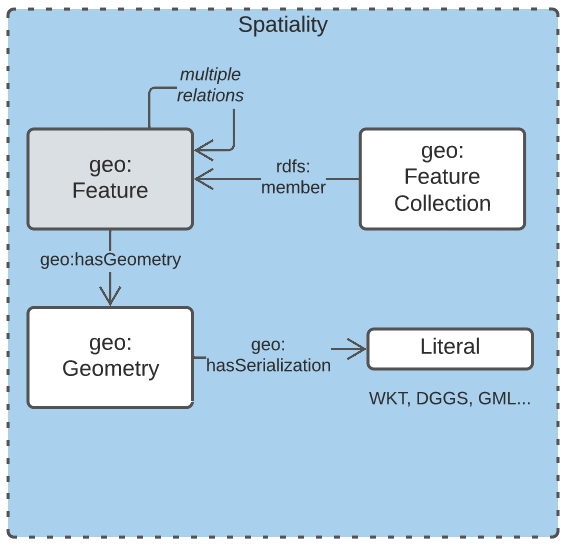
This Data Domain’s main classes are taken directly from GeoSPARQL 1.1 [GEO] which is used extensively in GA already. GeoSPARQL’s main purposes are to relate things (geo:Feature) to their spatial projections - their geometries - and to relate things to one another - topological relations between features, such as within, touches, disjoint etc.
Particular datasets tend to implement specialised types of things (usually referred to as Feature Types) and sometimes specialised relations between things, e.g. special hydrological catchment feature type might relate to another by being upstream of it. This is as per modelling in the Geofabric [3].
4.4.5. Theming
This subsection details the main elements of the Theming Data Domain.
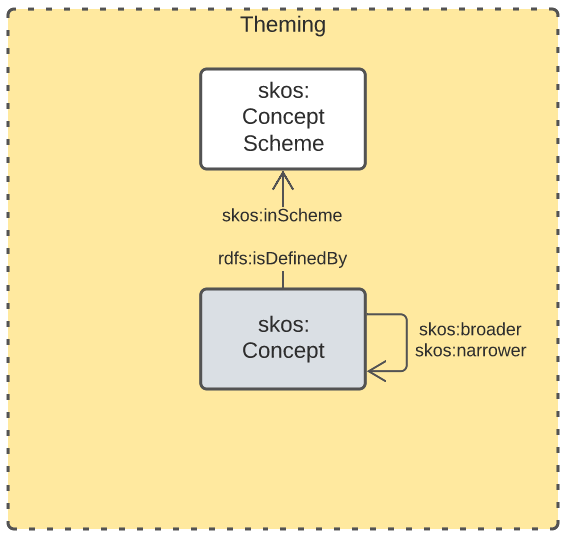
This Data Domain’s main classes are taken from [SKOS] and their expected/required properties and relations are formally defined in VocPub, a "vocabulary publication profile of SKOS" [VOCPUB]. VocPub just mandates certain vocabulary metadata and relations between elements in vocabularies. Conformance of vocabularies to VocPub is also easily testable using the profile’s validator and online tooling that support it [4].
4.5. Data Domains Details
The Data Domains described above are implemented using multiple models and other resources. The following subsections describe the Domains' details and link to resources within them, such as Component Models.
4.5.1. Data Cataloguing Domain
Models
| Model | Role | Notes |
|---|---|---|
Data Catalog Vocabulary [DCAT] |
Domain main model |
Supplies main modelling structures for this domain |
4.5.2. Organisations & People Domain
Models
| Model | Role | Notes |
|---|---|---|
Domain main models |
Supplies main modelling structures for this domain. |
4.5.3. Sampling Domain
Models
| Model | Role | Notes |
|---|---|---|
Semantic Sensor Network ontology [SSN] |
Domain main model |
Supplies main modelling structures for this domain |
TERN Ontology [TERN] |
Supporting Model |
Based on the Semantic Sensor Network Ontology [SSN], this model is used to characterise sites and field sampling:
|
A Component Data Model defined for this Supermodel. Caters for detailed Material Sample properties; Specialised Sites modelling |
A profile of several ontologies and a Semantic Web implementation of the Sampling Features Schema described in clauses 9-11 of [ISO19156]. Directly inherits from: |
|
Background Model |
A Semantic Web implementation of the Sampling Features Schema described in clauses 9-11 of [ISO19156] that was used for GA samples modelling 2015 - 2022. This ontology is no longer in direct use but is the foundation for the GA Samples Ontology |
|
|
The Loop3D initiative's GeoScience Ontology |
Alignment target |
Incomplete The Loop3D GSO is a detailed geology model and attempts are being made to align GA Samples data with it. |
Examples: Sample
Example representations of a Sample, http://pid.geoscience.gov.au/sample/AU128, according to one of the models listed above, is given below.
Representations of AU128 according to all of the models listed above is delivered by the GA Samples API online at:
See also complete static data examples fpr AU128:
Example data according to the [GAS]:
@prefix role: <http://def.isotc211.org/.../CI_RoleCode/> .
@prefix sample: <http://pid.geoscience.gov.au/sample/> .
@prefix samples: <http://pid.geoscience.gov.au/samples> .
sample:AU128
a tern:MaterialSample , geo:Feature ;
rdfs:label "Sample igsn:AU128" ;
dcterms:identifier "https://igsn.org/AU128"gas:IGSN ;
sosa:isSampleOf <http://pid.geoscience.gov.au/site/17594> ;
gas:samplingLocation [
a geo:Geometry ;
geo:asWKT "<http://www.opengis.net/def/crs/EPSG/0/4283> POINT(137.6250691792 -34.0411726571)"^^geo:wktLiteral ;
] ;
gas:currentLocation [
a dct:Location ;
dct:description "GA Services building" ;
] ;
gas:samplingMethod <http://pid.geoscience.gov.au/def/voc/ga/igsncode/Rock> ;
prov:hasQualifiedAttribution [
prov:actor [
a sdo:Person ;
sdo:name "Raymond, O.L." ;
] ;
prov:hadRole role:originator ;
] ,
[
prov:actor <http://linked.data.gov.au/org/ga> ;
prov:hadRole role:custodian ;
] ;
.
samples: rdfs:member <http://pid.geoscience.gov.au/sample/> .In the exmple data above, the sample AU128 is identified using the Persistent IRI http://pid.geoscience.gov.au/sample/AU128 which is shortened to sample:AU128 using a prefix.
It is declared to be of certain classes:
-
tern:MaterialSample- a physical sample of something -
geo:Feature- a geospartial Feature
It has a basic label, "Sample igsn:AU128", and an alternate identifier, the International GeoSample Number (IGSN) “https://igsn.org/AU128”.
It is a sample of Site 17594, a sampling location, a geometry, and a current location are given, as is a sampling method (clearly incorrect here!) and is indicated as being a member of a Feature Collection http://pid.geoscience.gov.au/sample/ - the list of all GA’s Samples.
Finally, two Agents are indicated as haveing roles in relation to this sample:
-
a person "Raymond, O.L." - the sample’s originator
-
a more specialised role for this might be defined shortly
-
-
<http://linked.data.gov.au/org/ga>(Geoscience Australia) - the sample’s custodian
4.5.4. Spatiality Domain
Models
| Model | Role | Notes |
|---|---|---|
GeoSPARQL 1.1 [GEO] |
Domain main model |
Supplies main modelling structures for this domain |
4.5.5. Theming Domain
Models
| Model | Role | Notes |
|---|---|---|
Simple Knowledge Organization system (SKOS) ontology [SKOS] |
Domain main model |
Supplies main modelling structures for this domain |
Examples
To do

Surveys are a subclass of Samplings, and where the survey took place at a site, are related to the site through a tern:SiteVisit. Soft typing of surveys is done through the dcterms:type property, and vocabularies for types and methods of surveys are defined in the [xx] and [yy] vocabularies

Additional classes in this domain cater for special forms of Sites and Samples. See the Sampling Domain detailed section below.
Annex A: Profile Requirements
Requirements for this specification are organised as perr the classes within the GA Supermodel. See the Supermodel main documentation for more information.
A.1 Material Sample Class
tern:MaterialSample
The TERN Ontology defines a tern:MaterialSample subclass of SOSA's Sample class which is used by GA for physical samples.
| ID | Title | Rule | Notes |
|---|---|---|---|
Material Sample IGSN |
Each Material Sample MUST indicate an IGSN with a |
||
Material Sample Sample ID |
Each Material Sample MUST indicate an GA Sample ID with a |
||
Material Sample State |
Each Material Sample MAY indicate the Australian State they were aquired within with a |
||
Material Sample Date Aquired |
Each Material Sample MUST indicate the date at which it was aquired with the |
||
Material Sample Sampling Location |
Each Material Sample MUST indicate exactly one location at which it was aquired with the |
Annex B: PID Policy
-
sources of principles
-
previous GA practice
-
AGLDWG
-
international practice
-
-
own principles
-
as flat as possible
-
reject old /def/voc/ga/…
-
classes only
-
-
References
-
[ABIS] Department of Agriculture, Water and the Enviroment, Australia Biodiversity Information Standard (ABIS), Australian government Semantic Web Standard (2022-01-14). https://linked.data.gov.au/def/abis
-
[DCTERMS] DCMI Usage Board, DCMI Metadata Terms, A DCMI Recommendation (2020-01-20). https://www.dublincore.org/specifications/dublin-core/dcmi-terms/
-
[DCAT] World Wide Web Consortium, Data Catalog Vocabulary (DCAT) - Version 2, W3C Working Group Note (04 February 2020). https://www.w3.org/TR/vocab-dcat/
-
[GAS] Geoscience Australia, GA Samples Profile (2022). Geoscience Australia ontology. https://linked.data.gov.au/def/gas
-
[GEO] Open Geospatial Consortium, OGC GeoSPARQL - A Geographic Query Language for RDF Data, Version 1.1 (2021). OGC Implementation Specification. http://www.opengis.net/doc/IS/geosparql/1.1
-
[ISO19156] International Organization for Standardization, ISO 19156: Geographic information — Observations and measurements (2011)
-
[OWL] World Wide Web Consortium, OWL 2 Web Ontology Language Document Overview (Second Edition), W3C Recommendation (11 December 2012). https://www.w3.org/TR/owl2-overview/
-
[PROF] World Wide Web Consortium, The Profiles Vocabulary, W3C Working Group Note (18 December 2019). https://www.w3.org/TR/dx-prof/
-
[PROV] World Wide Web Consortium, PROV-O: The PROV Ontology, W3C Working Group Note (18 December 2019). https://www.w3.org/TR/prov-o/
-
[SAM] Cox, S.J.D., OWL representation of ISO 19156 Sampling Features model. (2014). Online at: https://surroundaustralia.github.io/ga-supermodel/sam-lite.html, accessed 2022-03-02
-
[SDO] W3C Schema.org Community Group, schema.org. Community ontology (2015). https://schema.org
-
[SSN] World Wide Web Consortium, Semantic Sensor Network Ontology, W3C Recommendation (19 October 2017). https://www.w3.org/TR/vocab-ssn/
-
[SKOS] World Wide Web Consortium, SKOS Simple Knowledge Organization System Reference, W3C Recommendation (18 August 2009). https://www.w3.org/TR/skos-reference/
-
[TERN] Terrestrinal Ecosystems Research Network, TERN Ontology, Organisation ontology (2022). https://linkeddata.tern.org.au/viewers/tern-ontology
-
[TTL] World Wide Web Consortium, RDF 1.1 Turtle Terse RDF Triple Language, W3C Recommendation (25 February 2014). https://www.w3.org/TR/turtle/
-
[VOCPUB] SURROUND Australia Pty Ltd, VocPub, Profile of SKOS (14 June 2020). https://w3id.org/profile/vocpub
